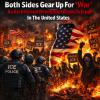
Breaking News
 BREAKING EXCLUSIVE: Kyle Rittenhouse Warns The Left Is Preparing To Stage A False Flag To Blame...
BREAKING EXCLUSIVE: Kyle Rittenhouse Warns The Left Is Preparing To Stage A False Flag To Blame...
 The Biggest Grid We Escaped (It Wasn't Power)
The Biggest Grid We Escaped (It Wasn't Power)
 Both Sides Gear Up For "War" As An Internal Revolution Begins To Erupt In The United State
Both Sides Gear Up For "War" As An Internal Revolution Begins To Erupt In The United State
 The Good News Is People Are Realizing We're On Our Own
The Good News Is People Are Realizing We're On Our Own
Top Tech News
 World's most powerful hypergravity machine is 1,900X stronger than Earth
World's most powerful hypergravity machine is 1,900X stronger than Earth
 New battery idea gets lots of power out of unusual sulfur chemistry
New battery idea gets lots of power out of unusual sulfur chemistry
 Anti-Aging Drug Regrows Knee Cartilage in Major Breakthrough That Could End Knee Replacements
Anti-Aging Drug Regrows Knee Cartilage in Major Breakthrough That Could End Knee Replacements
 Scientists say recent advances in Quantum Entanglement...
Scientists say recent advances in Quantum Entanglement...
 Solid-State Batteries Are In 'Trailblazer' Mode. What's Holding Them Up?
Solid-State Batteries Are In 'Trailblazer' Mode. What's Holding Them Up?
 US Farmers Began Using Chemical Fertilizer After WW2. Comfrey Is a Natural Super Fertilizer
US Farmers Began Using Chemical Fertilizer After WW2. Comfrey Is a Natural Super Fertilizer
 Kawasaki's four-legged robot-horse vehicle is going into production
Kawasaki's four-legged robot-horse vehicle is going into production
 The First Production All-Solid-State Battery Is Here, And It Promises 5-Minute Charging
The First Production All-Solid-State Battery Is Here, And It Promises 5-Minute Charging
 See inside the tech-topia cities billionaires are betting big on developing...
See inside the tech-topia cities billionaires are betting big on developing...
New molten salt battery for grid-scale storage runs at low temp and cost

One potential solution is known as a molten salt battery, which offers advantages that lithium batteries do not, but have their share of kinks to iron out, too. Scientists at Sandia National Laboratories have come up with a new design that addresses a number of these shortcomings, and demonstrated a working molten salt battery that can be constructed far more cheaply, while storing more energy, than currently available versions.
Storing vast amounts of energy in a cheap and efficient manner is the name of the game when it comes to powering whole cities with renewable energy, and despite its many strengths, this is where expensive lithium battery technology falls short. Molten salt batteries shape as a more cost-effective solution, which use electrodes kept in a molten state with the help of high temperatures. This is something that the Sandia scientists have been working to change.
"We've been working to bring the operating temperature of molten sodium batteries down as low as physically possible," says Leo Small, the lead researcher on the project. "There's a whole cascading cost savings that comes along with lowering the battery temperature. You can use less expensive materials. The batteries need less insulation and the wiring that connects all the batteries can be a lot thinner."
In their commercial form, these batteries are known as sodium-sulfur batteries, and a few of these have been developed around the world but generally operate at 520 to 660 °F (270 to 350 °C). The Sandia team have set their sights much lower, although doing so required a rethink as the chemistries that work at high temperatures don't lend themselves well to lower temperatures.

 Storage doesn't get much cheaper than this
Storage doesn't get much cheaper than this

